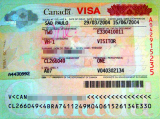ISS is available virtually and in-person Mondays-Fridays during business hours.

Only citizens of certain countries require a Temporary Resident Visa (TRV) to enter Canada. A TRV is sometimes referred to as a Visitor Visa or Entry Visa.
Do I need to apply for a visitor visa (TRV)?
U.S. citizens and permanent residents are both TRV and eTA exempt (i.e., they are not required to hold either a Visitor Visa or an eTA in order to enter Canada).
Depending on your country of citizenship, you may be required to have either a Temporary Resident Visa (TRV, also referred to as a “Visitor Visa” or “Entry Visa) or an Electronic Travel Authorization (eTA) in order to enter Canada.
- If you apply for your study permit from outside of Canada, your TRV will be issued automatically once your application is approved
- If you apply for your study permit from inside of Canada, you will need to apply separately for a TRV, after your study permit application has been approved
If you require an eTA, see here for our eTA application guide.
Do I need to apply separately for my TRV?
Depending on where you are applying from, you may or may not need to apply separately for your TRV.
International students outside of Canada
If you will be applying for your study permit from outside of Canada, you do not have to apply separately for your TRV. Your TRV will be issued to you automatically once your study permit application is approved.
When your study permit or work permit has been approved, you will be asked to submit your passport to the Visa Office so that the TRV (a counterfoil) can be placed inside your passport. Before travelling to Canada, you should have obtained both your Port of Entry (POE) Letter of Introduction and your TRV from the Visa Office. In general, a TRV will be issued for multiple entries.
Upon arrival at your Port of Entry (e.g. airport or land border), you must show your TRV, your POE Letter of Introduction, and your CAQ in order to obtain your study permit. You can read more about how to prepare to arrive in Canada as a student.
International Students already in Canada
If you will be applying for your study permit from inside of Canada as a high school student or as an exchange or visiting student, you must apply separately for your TRV after your study permit application has been approved. Your TRV will not be automatically issued to you when your study permit application is approved.
You can read about how to apply for your TRV in our Renewing Visitor Visa (TRV/Entry Visa) guide.
1-Term exchange students outside Canada NOT applying for CAQ & Study Permit
If you will be studying at McGill for 6 months or less (e.g. one-term exchange), you are not required to have a CAQ and Study Permit. You may, however, wish to apply for CAQ and Study Permit depending on your plans.
If you are a one-term exchange student and you have decided not to apply for a CAQ and Study Permit and you require a TRV to enter Canada, see our guide on how to apply for your TRV above.
What if my TRV has expired?
You may remain in Canada if your TRV has expired. However, if you exit Canada, you will need a valid TRV in order to re-enter Canada.
If you leave Canada and travel to the U.S. only, you may request re-entry to Canada even if your TRV has expired as long as you will return to Canada before the end of your approved stay in Canada (e.g. before your Study Permit or Post Graduation Work Permit expires). You can read more about expired TRVs and travelling as a student on this Government of Canada website.